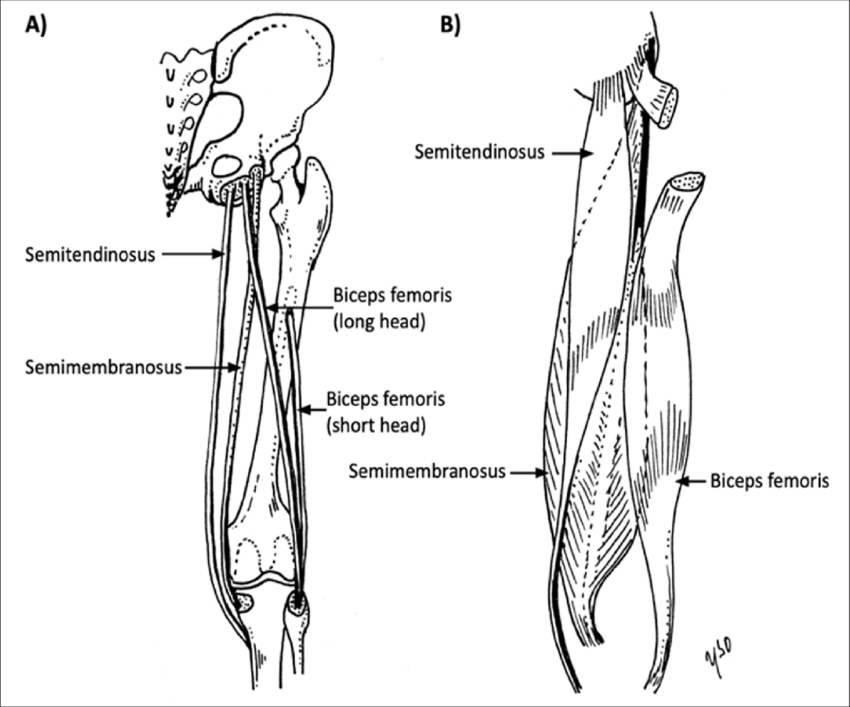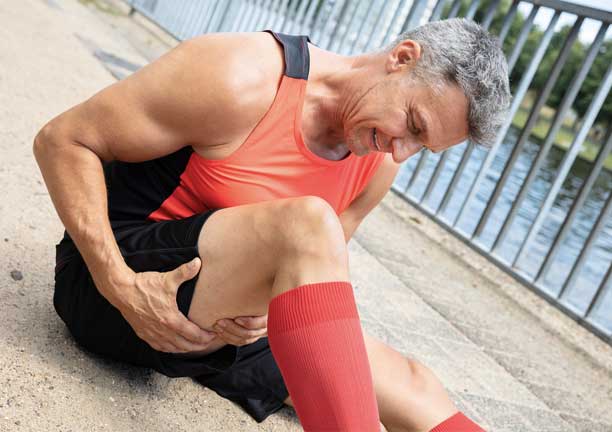Medically Reviewed by Dr. Angelo Ciminiello
Key Takeaways
- A pulled hamstring usually causes sudden pain, tenderness, swelling, and reduced mobility.
- More severe strains may cause bruising, a popping sound, or visible muscle deformity.
- Self-assessments help, but diagnosis by a specialist ensures proper treatment.
- Don’t push through the pain. Rest and get evaluated if symptoms persist or worsen.
This guide is for active adults, athletes, or weekend warriors who suspect they’ve pulled their hamstring and want to know what signs to look for and what to do next.
A hamstring strain, also known as a pulled hamstring, is a common injury that occurs when the muscles at the back of the thigh are stretched or torn. It typically happens during activities that involve sudden movements, excessive stretching, or forceful contractions of the hamstring muscles. The severity of a hamstring strain can range from mild to severe, affecting mobility and causing pain.
Common causes of hamstring strains include inadequate warm-up, muscle imbalances, fatigue, and previous injuries. Factors like age, poor flexibility, and inadequate conditioning can also increase the risk. Recognizing the signs and symptoms of a pulled hamstring is important for diagnosis and appropriate treatment.
7 Signs of a Strained Hamstring
A strained hamstring can be identified by several signs that indicate injury or damage to the muscles or tendons at the back of the thigh. Here are 7 key signs to watch for:
1. Pain
One of the most common signs of a strained hamstring is pain in the back of the thigh. The intensity of the pain may vary depending on the severity of the strain.
2. Tenderness
The affected area may feel tender to the touch. Gentle pressure on the hamstring muscles can elicit discomfort or pain.
3. Swelling
In some cases, a strained hamstring may cause swelling around the injured area. The swelling may be localized or spread across a larger portion of the thigh.
4. Bruising
If the strain is severe, it can lead to bruising around the hamstring muscles. The presence of bruising indicates internal bleeding or tissue damage.
5. Muscle Weakness
A strained hamstring can result in muscle weakness, making it difficult to perform activities that require strength and power, such as running or jumping.
6. Limited Range of Motion
The range of motion in the affected leg may be reduced. You may experience difficulty in fully extending the leg or bending it at the knee.
7. Audible “Pop” Sound
In some cases, a strained hamstring may be accompanied by an audible “pop” sound at the time of injury. This can indicate a more severe strain or muscle tear.
How to Know If You Pulled or Tore Your Hamstring
Differentiating between a pulled or strained hamstring and a torn hamstring requires careful assessment of various factors. When evaluating the severity of a hamstring injury, one distinguishing factor is the intensity of pain. A pulled hamstring typically causes a sudden, sharp pain at the back of the thigh, while a torn hamstring may result in more severe and persistent pain.
Another distinguishing characteristic is immediate weakness or the inability to bear weight on the affected leg, which suggests a more significant hamstring tear rather than a simple strain.
The occurrence of an audible “pop” sound or sensation at the time of injury is often associated with a hamstring tear, indicating a significant tear in the muscle fibers. Additionally, extensive bruising that develops within a few days after the injury is more commonly seen in cases of muscle tears.
Observation of a visible gap or dent in the muscle may also indicate a complete tear and requires medical assessment for accurate diagnosis.
In terms of mobility, a pulled hamstring may limit the range of motion and cause discomfort during leg movements. However, a torn hamstring can significantly impair mobility, making it difficult to walk or bend the knee. Moreover, a torn hamstring often results in a noticeable loss of muscle function, making it challenging to contract or engage the affected muscles.

The Pulled Hamstring Test
While it is possible to perform some self-assessment techniques to get an idea of a possible pulled hamstring, it is important to note that self-testing may not provide a definitive diagnosis.
A healthcare professional, such as an orthopedic specialist or a physical therapist, is best equipped to assess and diagnose a pulled hamstring accurately. However, you can try the following self-assessment methods:
- Pain and tenderness: Pay attention to any localized pain or tenderness in the back of the thigh, specifically in the area of the hamstring muscles.
- Range of motion: Gently test your ability to straighten and bend your knee. If you experience pain or difficulty with knee flexion, it may indicate a strained hamstring.
- Strength and stability: Evaluate the strength and stability of your leg by attempting to perform simple movements like walking, jogging, or hopping. If you notice weakness, instability, or difficulty with these activities, it could suggest a hamstring injury.
- Swelling and bruising: Look for any visible signs of swelling or bruising in the back of the thigh, as these may be indicative of a more severe hamstring injury.
If you suspect a pulled hamstring or experience persistent pain, it is recommended to consult with a qualified healthcare professional for a comprehensive examination and accurate diagnosis. They can provide proper guidance, treatment options, and help you with the necessary steps for recovery.
Diagnosis of a Hamstring Strain
If you experience sharp and acute pain in your hamstring after performing physically challenging cardio workouts, then chances are you’ve injured the muscle. To prevent aggravating the sprain or injury, you should stop doing any further exercises if you feel any negative or painful effects.
You should consult a Sports Medicine specialist at OrthoConnecticut who will perform a thorough physical examination to diagnose the injury.
The physicians at OrthoConnecticut will want to understand the circumstances of the injury. The doctor will review your medical history and estimate the extent of damage through palpation, i.e., by physically touching the affected area to examine the size, consistency, texture, location, and tenderness of it.
Understanding each patient’s medical history is crucial. It helps your physician determine if arthritis of the knee, hip or back or earlier injuries has reduced your overall muscle flexibility or range of motion, which makes the hamstring more vulnerable to sprain.
Palpating the muscle itself enables your doctor to evaluate the level of soreness or inflammation. Your doctor will determine whether the injury is grade one, two or three by pressing his fingers across the muscle. The physician will evaluate your motion, by having you perform a set of movements related to the back, hip, and knee to assess the intensity of pain if it cannot be detected by palpation.
Learn more about the treatment and recovery time of this type of injury in this article: Pulled Hamstrings: Everything You Need to Know.
Frequently Asked Questions About Hamstring Injuries
Walking can be beneficial for a pulled hamstring, but it should be done with caution. Initially, it is important to rest and protect the injured hamstring to promote healing. As the pain and swelling subside, gentle walking can help improve blood flow and promote recovery. However, it is crucial to start slowly and avoid activities that cause pain or strain the hamstring. Gradually increase the intensity and duration of walking as the hamstring heals and under the guidance of a healthcare professional or physical therapist.
The recovery time for a pulled hamstring can vary depending on the severity of the injury and individual factors. Mild hamstring strains may heal within a few weeks with proper rest, rehabilitation exercises, and conservative treatments. Moderate strains may take several weeks to a couple of months to heal. Severe hamstring tears may require a longer recovery time, typically ranging from three to six months or more. You should follow a comprehensive treatment plan, including rest, rehabilitation exercises, and gradual return to activity, to ensure proper healing and reduce the risk of reinjury.
Treatment for a pulled hamstring involves a combination of self-care measures, rehabilitation exercises, and medical interventions. Initially, the R.I.C.E. (rest, ice, compression, elevation) protocol is commonly recommended to reduce pain and swelling. Over-the-counter pain medications can also be used to manage discomfort. Physical therapy plays a crucial role in the rehabilitation process, focusing on stretching, strengthening, and flexibility exercises to promote healing and prevent future injuries. In some cases, more advanced treatments like ultrasound therapy, electrical stimulation, or corticosteroid injections may be utilized.
A strain is a stretch or minor tear. A full tear involves more severe damage and often leads to bruising and sharp pain



















